Inpression Editing
Copy & Content That Makes Your Brand Soar

“Before” vs. “prior to”: What’s the difference?
If you’re someone who writes or creates content, there’s a dilemma you’ve probably faced: whether to use “before” vs. “prior to” in a particular sentence. For example, which one could you use here: “We considered all the evidence _____ making a decision”? Would you choose “before” or would you place your bets on “prior to”? You may be confident that you know which one fits. But do you really know the right answer?
“Before” vs. “prior to”: Which word could you use?
We’ve got good news for you: no matter which word you chose, you’re right. You can use either “before” or “prior to” in the sentence:
- “We considered all the evidence before making a decision.”
- “We considered all the evidence prior to making a decision.”
Why can you use either word? Because “before” vs. “prior to” mean the same thing. In fact, if you look up both words in major dictionaries (e.g., the Merriam-Webster Dictionary , Oxford Dictionaries , and the Collins Dictionary ), you’ll find that the definition of “prior to” is “before.” That’s why you could use either “before” or “prior to” in all these sentences:
- “Before attending law school, Janessa worked as a teacher.”
- “Prior to attending law school, Janessa worked as a teacher.”
- “They needed to finish the layout for the magazine before leaving for the day.”
- “They needed to finish the layout for the magazine prior to leaving for the day.”
- “You must let the chocolate cool before moving on to the next step.”
- “You must let the chocolate cool prior to moving on to the next step.”
“Before” vs. “prior to”: Which word should you use?
Now, just because you can use either “before” or “prior to” in any sentence doesn’t mean you should. It’s true that “before” vs. “prior to” are both grammatically correct choices for a sentence. But that doesn’t mean that they’re equally good choices.
If you read our posts on a regular basis, you’ll know that we like to keep things simple . That is, we always suggest using the simplest words that you can use in a sentence. Simple words make sentences easier to read and understand, and your number one job as a writer is to make your reader’s job as easy as possible. That’s why we believe “before” is always a better choice than “prior to.”
We know what some of you are thinking: “‘prior to’ is a better fit for a project proposal or report because it sounds more formal.” After all, you’re probably used to seeing corporate and legal documents that are peppered with this term. In reality, though, “prior to” is just a Latin-based synonym of “before” that sounds unnecessarily formal. In fact, the Merriam-Webster dictionary notes that some people even see “prior to” as pompous. And you don’t want to seem pompous, do you?
Remember that smart people are impressed by how clearly and simply you can explain something, not by how complex your writing is. That’s why we suggest resisting the temptation to use “prior to” and going with “before” no matter what. After all, there’s really no situation where you would need to use “prior to” instead of “before.”
“Before” vs. “prior to” may feel like different words that are appropriate for different types of sentences. But the reality is that they mean the same thing. That’s why no matter what you’re trying to say, you can simplify and strengthen your writing by using “before” instead of “prior to.”
—————————————————————————————————————————————
Want more tips on how to produce clear and concise content? Read our post on how to shorten long words and sentences .
————————————————————————————————————————————— Inpression Editing helps businesses, professionals, and students make the best impression possible on customers, investors, hiring managers, and admissions committees. We do this by providing copywriting, editing, and writing coaching services for website copy, blog posts, marketing materials, personal statements, and much more.
Located in Toronto, Canada, we provide all of our services in both Canadian and US English. Get an instant quote here .
- ← 5 blog post headline mistakes you need to stop making
- 9 blog title generator tools to help you craft the perfect headline + 72 title templates →
Leave a Reply Cancel reply
Your email address will not be published. Required fields are marked *
- More from M-W
- To save this word, you'll need to log in. Log In
preposition
Definition of prior to.
Sometimes termed pompous or affected, prior to is a synonym of before that most often appears in rather formal contexts, such as the annual reports of corporations. It may occasionally emphasize the notion of anticipation.
- afore [ chiefly dialect ]
- fore [ chiefly dialect ]
- 'fore
- previous to
Examples of prior to in a Sentence
These examples are programmatically compiled from various online sources to illustrate current usage of the word 'prior to.' Any opinions expressed in the examples do not represent those of Merriam-Webster or its editors. Send us feedback about these examples.
Word History
1706, in the meaning defined above
Dictionary Entries Near prior to
Cite this entry.
“Prior to.” Merriam-Webster.com Dictionary , Merriam-Webster, https://www.merriam-webster.com/dictionary/prior%20to. Accessed 9 May. 2024.
Kids Definition
Kids definition of prior to, more from merriam-webster on prior to.
Nglish: Translation of prior to for Spanish Speakers
Subscribe to America's largest dictionary and get thousands more definitions and advanced search—ad free!

Can you solve 4 words at once?
Word of the day.
See Definitions and Examples »
Get Word of the Day daily email!
Popular in Grammar & Usage
More commonly misspelled words, your vs. you're: how to use them correctly, every letter is silent, sometimes: a-z list of examples, more commonly mispronounced words, how to use em dashes (—), en dashes (–) , and hyphens (-), popular in wordplay, 12 star wars words, a great big list of bread words, 10 scrabble words without any vowels, 8 uncommon words related to love, 9 superb owl words, games & quizzes.

- Format Type
- Learning Modules
- Interactives
- Credit Type
- Participation Certificate

- AMA Ed Hub >
- AMA STEPS Forward >

AMA STEPS Forward ® presents actionable, practical toolkits and customizable resources that you can use to successfully implement meaningful and transformative change in your practice or organization. See How it Works
- Practice Innovation Topics
- Time-Saving Strategies
- Physician Burnout
- Future of Health
- Behavioral Health Integration
- EHR Improvements
- Patient-Centered Care
- Leadership and Culture
- Private Practice
- explore all topics
Pre-Visit Planning Case Report: Prairie Lake Family Medicine
Pre-visit planning case report: autumn ridge family medicine, pre-visit planning case report: fairview health services, success story: pre-visit laboratory testing can improve communication with patients about test results, success story: decrease patients with poorly controlled diabetes by one-third, watch how the mayo clinic implemented a pre-visit planning process.
- Core Workflow Toolkits
- Annual Prescription Renewal
- Daily Huddles
- Team Meetings
- Team Documentation
- In-Basket Management
- Pre-Visit Lab Testing
- Pre-Visit Planning
- Expanded Rooming and Discharge Protocols
See More About
Ama cme accreditation information.
Credit Designation Statement: The American Medical Association designates this enduring material activity for a maximum of 0.50 AMA PRA Category 1 Credit(s) ™. Physicians should claim only the credit commensurate with the extent of their participation in the activity.
CME Disclosure Statement: Unless noted, all individuals in control of content reported no relevant financial relationships.
If applicable, all relevant financial relationships have been mitigated.
Credit Renewal Dates: April 25, 2019, April 24, 2022
Disclaimer: AMA STEPS Forward™ content is provided for informational purposes only, is believed to be current and accurate at the time of posting, and is not intended as, and should not be construed to be, legal, financial, medical, or consulting advice. Physicians and other users should seek competent legal, financial, medical, and consulting advice. AMA STEPS Forward™ content provides information on commercial products, processes, and services for informational purposes only. The AMA does not endorse or recommend any commercial products, processes, or services and mention of the same in AMA STEPS Forward™ content is not an endorsement or recommendation. The AMA hereby disclaims all express and implied warranties of any kind related to any third-party content or offering. The AMA expressly disclaims all liability for damages of any kind arising out of use, reference to, or reliance on AMA STEPS Forward™ content.
About the AMA Professional Satisfaction and Practice Sustainability Group: The AMA Professional Satisfaction and Practice Sustainability group is committed to making the patient–physician relationship more valued than paperwork, technology an asset and not a burden, and physician burnout a thing of the past. We are focused on improving—and setting a positive future path for—the operational, financial, and technological aspects of a physician's practice. To learn more, visit https://www.ama-assn.org/practice-management .
Disclaimer: AMA STEPS Forward ® content is provided for informational purposes only, is believed to be current and accurate at the time of posting, and is not intended as, and should not be construed to be, legal, financial, medical, or consulting advice. Physicians and other users should seek competent legal, financial, medical, and consulting advice. AMA STEPS Forward ® content provides information on commercial products, processes, and services for informational purposes only. The AMA does not endorse or recommend any commercial products, processes, or services and mention of the same in AMA STEPS Forward ® content is not an endorsement or recommendation. The AMA hereby disclaims all express and implied warranties of any kind related to any third-party content or offering. The AMA expressly disclaims all liability for damages of any kind arising out of use, reference to, or reliance on AMA STEPS Forward ® content.
Credit Designation Statement: The American Medical Association designates this Enduring Material activity for a maximum of 0.50 AMA PRA Category 1 Credit (s)™. Physicians should claim only the credit commensurate with the extent of their participation in the activity.
Successful completion of this CME activity, which includes participation in the evaluation component, enables the participant to earn up to:
- 0.50 Medical Knowledge MOC points in the American Board of Internal Medicine's (ABIM) Maintenance of Certification (MOC) program;;
- 0.50 Self-Assessment points in the American Board of Otolaryngology – Head and Neck Surgery’s (ABOHNS) Continuing Certification program;
- 0.50 MOC points in the American Board of Pediatrics’ (ABP) Maintenance of Certification (MOC) program;
- 0.50 Lifelong Learning points in the American Board of Pathology’s (ABPath) Continuing Certification program; and
- 0.50 credit toward the CME of the American Board of Surgery’s Continuous Certification program
It is the CME activity provider's responsibility to submit participant completion information to ACCME for the purpose of granting MOC credit.
AMA Membership provides:
- Unlimited CME and MOC from JN Learning
- Full-access to JAMA Network (print journal, online and audio subscription)
Sign in to access
Sign in to customize your interests, my saved searches.
You currently have no searches saved.
My Saved Courses
You currently have no courses saved.
Name Your Search
Sign in to save your search, lookup an activity, purchase access.
- Type 2 Diabetes
- Heart Disease
- Digestive Health
- Multiple Sclerosis
- Diet & Nutrition
- Supplements
- Health Insurance
- Public Health
- Patient Rights
- Caregivers & Loved Ones
- End of Life Concerns
- Health News
- Thyroid Test Analyzer
- Doctor Discussion Guides
- Hemoglobin A1c Test Analyzer
- Lipid Test Analyzer
- Complete Blood Count (CBC) Analyzer
- What to Buy
- Editorial Process
- Meet Our Medical Expert Board
Prior Authorization: Overview, Purpose, Process
Why some health insurers may deny a claim if you don't take this step
- Medications and Services
- How to Speed It Up
- Authorization Process
Prior authorization in health care is a requirement that a healthcare provider (such as your primary care physician or a hospital) gets approval from your insurance plan before prescribing you medication or doing a medical procedure.
Also Known As
Prior authorization is also known as precertification, predetermination, and pre-approval.
Without prior approval, your health insurance plan may not pay for your treatment (even if it would otherwise be covered by the plan), leaving you responsible for the full bill.
This article will cover what prior authorization in healthcare is, why and when health plans require prior authorization, and your options if a prior authorization request is denied by your health plan.
Why Do Health Insurers Require Prior Authorization?
Insurance providers use prior authorization to make sure that a specific medical service is really needed and worth the cost.
Your health insurance company uses prior authorization as a way to keep healthcare costs in check. Ideally, the process should help prevent too much spending on health care that is not really needed.
A pre-authorization requirement is a way of rationing health care . Your health plan is rationing paid access to expensive drugs and services, making sure the only people who get these drugs or services are the people for whom the drug or service is appropriate.
The idea is to ensure that health care is cost-effective, safe, necessary, and appropriate for each patient. In the process of prior authorization, your insurer will make sure that certain criteria are met.
Medical Necessity
Being medically necessary means that you really do need the service or drug your provider is prescribing.
When insurers are trying to determine if criteria for medical necessity are being met, they’re looking for factors like whether the treatment is recommended for your situation according to up-to-date, research-backed evidence.
They’re also checking to make sure that the service is not being duplicated. For example, if you have lung cancer you might be seeing more than one specialist. Your lung provider might order a chest CT scan , not realizing that your cancer provider had you get one two weeks ago.
In this case, your insurer would not pre-authorize the second CT scan until it has confirmed that your lung health provider saw the scan you had two weeks ago and still thinks you need to have another one.
Insurers also want to see if it makes financial sense for you to have a service or treatment. The procedure or drug should be the most economical treatment option for your condition.
For example, imagine that Drug C and Drug E both treat your condition. Drug C is cheaper and Drug E is more expensive.
If your healthcare provider prescribes Drug E, your health insurance plan may want to know why Drug C would not work just as well. If your provider can show that Drug E is a better option for you even though it costs more, it might get pre-authorized.
However, if there’s no medical reason why the more expensive Drug E should be chosen over the cheaper Drug C, your health plan may refuse to authorize it.
Some insurance companies require step therapy in these situations. Step therapy means that they'll only agree to pay for Drug E after you've tried Drug C and it has not helped. The same concept applies to other medical procedures—for example, they might not agree to an MRI unless your provider proves that an X-ray would not be enough.
Your insurance provider needs to make sure that ongoing or recurrent service is actually helping you.
For example, suppose you’ve been having physical therapy (PT) for three months and your provider is requesting authorization for another three months. In that case, your insurance plan might wonder if the PT is actually helping you.
The additional three months might be pre-authorized if you’re making slow but measurable progress. However, if you’re not making any progress or the PT is making you feel worse, your health plan might not agree to authorize any more PT sessions until it talks with your healthcare provider to better understand why they think another three months of PT will help you.
What Medications and Services Require Prior Authorization?
Prior authorization is generally not required for emergency services, as there wouldn't be time to request and receive it. (Retro authorization is occasionally used after the fact in emergency situations, although this is rare.) For certain types of non-emergency care, your insurance plan wants to make sure that the care is necessary and the most cost-efficient option.
If your doctor wants to prescribe a medication, your insurer may want to determine whether the drug is really needed and whether it's the best option for your situation. In some cases, your insurer might agree to give you a short-term supply of a medication (for example, one or three months) while they are making their decision.
Some types of medication are more likely to require prior authorization, including:
- Drugs with serious risks (such as severe side effects)
- Drugs that carry a high risk for misuse or addiction
- Drugs that are used for cosmetic reasons not for treating a condition
- Drugs that are expensive (especially if there is a lower-cost drug available to treat the condition you have)
Services That Require Prior Authorization
Some services, tests, or procedures are more likely than others to need prior authorization. Examples of services that commonly require prior authorization before being approved include:
- Diagnostic imaging (such as MRIs, CTs, and PET scans)
- Durable medical equipment (such as wheelchairs)
- Rehabilitation (like physical or occupational therapy)
- Home health services (such as nurses)
- Non-emergency surgery (elective surgery)
Does Medicare Require Prior Authorization?
Original Medicare ( Medicare Part A and Part B) generally does not require prior authorization.
Medicare Advantage plans often do require prior authorization. However, the federal government finalized new rules in 2023 to streamline Medicare Advantage's prior authorization processes and minimize how much prior authorization requirements prevent enrollees from receiving timely medical care.
How Long Does Prior Authorization Take?
The prior authorization process depends on the urgency of the need for treatment, where you live, and the type of health coverage you have. If your health plan is state-regulated (i.e., not a self-insured plan), the rules for prior authorization vary from one state to another.
At the federal level, the Biden administration proposed rules that would streamline the prior authorization process for Medicaid managed care plans, Medicare Advantage plans, and Marketplace/exchange plans that people purchase themselves. However, Marketplace plans are already subject to state rules for prior authorization because those plans are subject to state regulations.
The proposed rule would require health plans to respond within seven days to a non-urgent prior authorization request (the current requirement is within 14 days), and within 72 hours if the prior authorization request is urgent.
How to Speed Up Prior Authorization
The best way to make the prior authorization process go quickly is to tell your provider's office that you need prior authorization as soon as possible, get organized, keep track of due dates, and make sure all the paperwork you need to fill out is accurate and complete.
What Are the Rules of Prior Authorization?
Health plans each have their own rules in terms of what services need prior authorization. In general, the more expensive the procedure, the more likely a health plan is to require prior authorization. But some services will require prior authorization under one health plan and not under another.
Prior authorization requirements are also controversial, as they can often lead to treatment delays and can be an obstacle between patients and the care they need. For patients with ongoing, complex conditions that require extensive treatment and/or high-cost medications, continual prior authorization requirements can hinder their progress and place additional administrative burdens on providers and their staff.
Do I Need Prior Authorization in an Emergency?
If you need emergency medical care, most insurers do not require prior authorization. In some cases, they may do the authorization process after you get care (retroactive).
How Do I Get a Prior Authorization?
If you need to get prior authorization for a healthcare service, there’s a process that you'll need to follow.
Talk to Your Provider's Office
The first thing you'll need to do to start getting prior authorization is contact your provider's office. You’ll need to talk to the office person who handles prior authorization requests.
Once you find out who you need to talk to about getting prior authorization, the next step is to find out what they need from you. You can ask this person your questions about what to expect during the process and what you’ll have to do if your request is denied.
Fill Out Paperwork
Depending on how much information your medical provider already has, you may be asked to fill out forms that your provider's office will use to submit the request. A prior authorization form will include information about you, as well as your medical conditions and needs.
It's very important that you fill out these forms completely and make sure that the information is accurate. If there is information missing or wrong, it could delay your request or result in denied prior authorization.
Get Organized
As you're gathering and completing paperwork as part of your prior authorization request, make sure that you keep track of everything. You may need to go back to the paperwork later if the request is denied.
It's also helpful to have a record of approved prior authorizations in case you need to request another one in the future.
Keep Track of Dates
You may have deadlines for providing information. Your provider's office will probably be working on a timeline to submit documents during the prior authorization process. While your provider's office will help keep you up to date, it's also helpful if you know when things are due so you can set reminders for yourself.
Have a Plan if You're Denied
Talk to your provider and their office about what you will do if your prior authorization request is denied. You and your provider may choose to appeal the decision if you think the prior authorization denial was not justified.
If your prior authorization request is denied, the first step is to find out why. If a simple error was the problem, it might be a quick fix.
After you've checked all the paperwork that was submitted to make sure nothing is missing and all the information is correct, you might want to see if there are other things you could add that would help prove the medical care you're asking for is needed. For example, your provider might know of research that would be helpful to include.
Prior authorization means that a health provider needs to get approval from a patient’s health plan before moving ahead with a treatment, procedure, or medication.
Different health plans have different rules for when prior authorization is required. If prior authorization is required and is not obtained, the health plan can reject the claim—even if the procedure was medically necessary and would otherwise have been covered.
If your insurer denies coverage, you can ask them to reconsider. Your provider’s office can let you know what steps you need to take to appeal the decision.
Your medical provider will generally take the lead on submitting a prior authorization request and communicating with the health plan to improve the odds of approval. But the more you know about this process, the better you can advocate for the care you need.
American Medical Association. Prior authorization practice resources .
Tornese, Natalie. Outsource Strategies International. What Is Retro Authorization in Medical Billing? June 2023.
Blue Cross Blue Shield. Why do I need prior authorization for a prescription drug? .
Express Scripts. Common Terms .
MedicareFAQ. Medicare Prior Authorization Explained .
Centers for Medicare and Medicaid Services. 2024 Medicare Advantage and Part D Final Rule (CMS-4201-F) .
Dreher, Arielle. Axios. States jump into fight over prior authorization requirements . January 2023.
Centers for Medicare and Medicaid Services. CMS Proposes Rule to Expand Access to Health Information and Improve the Prior Authorization Process . December 2022.
Association of Health Care Journalists. Prior Authorization Rules: Yet Another Way the Health Insurance System Frustrates Physicians and Patients .
American Medical Association. 2021 prior authorization state law chart .
Cigna. What Is Prior Authorization? .
Aeta. Claim denials .
By Michael Bihari, MD Michael Bihari, MD, is a board-certified pediatrician, health educator, and medical writer, and president emeritus of the Community Health Center of Cape Cod.
Oak Street Health is part of CVS Healthspire™
18 Tips on Preparing for a Doctor’s Visit

Article at a glance
Insurance plays a large role in a patient’s access to healthcare. To learn more about how to prepare financially for a doctor visit, read this section .
Family history can greatly impact one’s current health and wellbeing. To learn more about what familial medical information is important to bring, read this section .
Medication affects a patient’s healthcare daily, therefore, it’s vital for a provider to understand which medicines their patient is taking. To learn more about how to prepare your medication list for your appointment, read this section .
Daily tracking devices are perfect for displaying what a patient’s daily health looks like. To learn more about which daily tracking devices are pertinent to bring, read this section .

Whether it’s a patient’s first time meeting with a doctor or they’re attending their annual check-up, there are a few things they need to keep in mind when they prepare for a doctor’s visit.
Ways to Prepare Prior to the Appointment
Arrive on time to the doctor’s appointment.
Care providers are often scheduled to see multiple patients a day while navigating around a busy schedule. In order for you to maximize the time you have with your provider, it’s important to arrive on time to the doctor’s office and avoid feeling rushed during your visit. It’s even better to show up to your appointment approximately 10–15 minutes early so there’s ample time for a nurse to check your vitals (height, weight, blood pressure, etc.) prior to seeing the doctor. To help keep you on schedule, record your appointment date and time on a calendar or in a planner once it’s made so you can incorporate it into your day.
Inform the Doctor’s Office of Accommodations
Before arriving at your appointment, it’s important to think through any accommodations the office should prepare for you. Such accommodations may include handicap parking or assistance, the help of an interpreter, the help of a translator, etc. If any such accommodations would be helpful during your visit, it’s important to call the office ahead of time so they can arrange everything accordingly for when you arrive.
Ensure the Office Takes Your Insurance
When it comes to finances, insurance plays a large role. Before finalizing an appointment with a provider or specialist, it’s important to ensure that the office accepts your primary form of insurance. Doing so will help you to avoid extra charges or fees for physicians that aren’t in your network. Oak Street Health locations accept a wide range of insurance providers and have a Care Team that’s ready and willing to walk their patients through their insurance benefits.
It’s also important to bring your insurance cards to the appointment along with your ID to make sure the office can scan your card, check your insurance coverage, and bill you appropriately.
To learn more about various insurance plans and what they provide, visit this source .
Route Your Trip
Before making an appointment, it’s important to plan your route and see where an office is located in relation to your home. Route how far it is to drive to the provider location or which public transportation options are available to take you there. Many insurance plans offer rides via services such as Uber or Lyft to assist their patients if necessary. Oak Street Health also provides transportation to and from appointments via company vans or rideshare services like Lyft, if needed.
Record Your Questions/Concerns
When finally meeting with the doctor, it can be overwhelming and easy to forget all of the questions or concerns you wanted to address. Prior to your appointment, it can be helpful to record a list of questions you want to ask, comments you want to make, or concerns you want to address with your doctor. When you’re finally at your visit, simply pull out the paper list or notes you made on your phone so you can mention all that was on your mind and receive the appropriate medical advice and treatment plan.

Items to Bring to the Appointment
Bring items for the waiting room.
There are going to be a variety of items you may need to bring along with you to your doctor’s appointment. Have a bag set aside that can carry all of your belongings, including a couple of items to entertain you while waiting to see the doctor. At times, there may be a wait prior to seeing your care provider. To help bide time, it’s good to bring a book, crossword puzzle, magazine, or other items along with you to keep you occupied.
Prepare for a Doctor’s Visit by Printing Out Test Results
Especially when establishing a relationship with a new doctor or provider, it’s important to have all prior medical tests and results printed out and documented for your visit. Pertinent test results may include but are not limited to past mammograms, colonoscopies, vaccination records, blood tests, and more. Don’t leave anything out and let the provider decide what’s relevant or not, that way they have a broad scope of understanding about your health history and care.
Gather Family Records
Family medical history can have a large impact on your current health and wellbeing. Compile all family medical records or a list of familial health conditions for your doctor to see. Certain conditions may be genetic, inciting a need for certain preventative health measures or screenings to be taken with your care. If possible, talk with family members, such as mothers or fathers, about their health history and any medical incidences they’ve struggled with. Knowing any familial medical issues can aid you in maintaining a healthy lifestyle throughout the years ahead.
Compile All Past & Current Medications to Bring
Make a list of any past or current medications for your provider to see, even if they’re over-the-counter drugs. This list should include dosage levels and how frequently you are taking them. If taking multiple medications, bring the bottles or packs in with you, even if they’re expired or empty. Having all medications laid out in front of them, allows a provider to check for duplicates, see if any refills are necessary, and generally aid the patient in organizing their medicinal routine. Furthermore, it’s important to be honest with the provider about which medications you’re on, why you’re on them, and how often you are truly taking them as it plays a large role in your healthcare. Don’t be afraid to explain hesitancies, ask questions, or talk through any side effects or concerns you have surrounding any medications you’re on or recommended to be on.
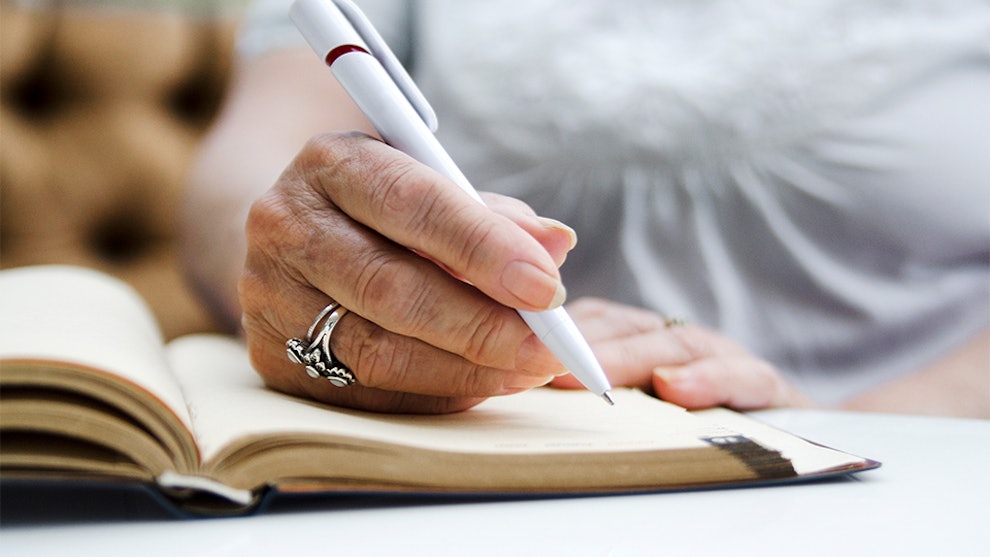
Create a List of Past & Current Providers
Before attending your doctor’s visit, compile a list of all other doctors from the past along with current care providers or specialists you see. If possible, record their contact information as well so that the provider you are visiting can reach out and your doctors can come together as a comprehensive care unit.
Record Any Allergies, Prior Surgeries, or Current Medical Conditions
Any allergies should be recorded and discussed with your physician e.g. food allergies, seasonal allergies, allergies to medicine, etc. Allergies impact a patient’s daily health and influence which medications they can or cannot take. Furthermore, any prior surgeries, visits to the emergency room, and medical incidents or conditions should be listed for your provider to be aware of so they have a full understanding of their patient’s medical history.
Record Any Current Issues or Symptoms
If a patient is experiencing new symptoms of a medical issue or concern since their last visit, it’s important for them to compile information surrounding the problem prior to seeing the doctor. For guidance on how to record information about your health concerns, follow the famous OPQRST method.
O: Onset of the event
What were you doing when the pain began?
Is the pain sudden, gradual, or chronic?
P: Provocation of the problem.
Activity: standing, lifting, twisting, etc.
Position: sitting, standing, lateral, etc.
Adjuvant: Does any medication or alternative tool such as heat, ice, massage therapy, etc. alleviate the pain?
Q: Quality of the pain.
Is the pain throbbing, dull, aching, sharp, etc.?
R: Region and radiation of the pain.
Where is the pain located on the body?
Does it stem out to any other parts of the body?
S: Severity of the pain.
Score the pain on a scale of 1 to 10.
T: Timing of the event.
When did the pain originate?
Has it gotten better or worse since it began?
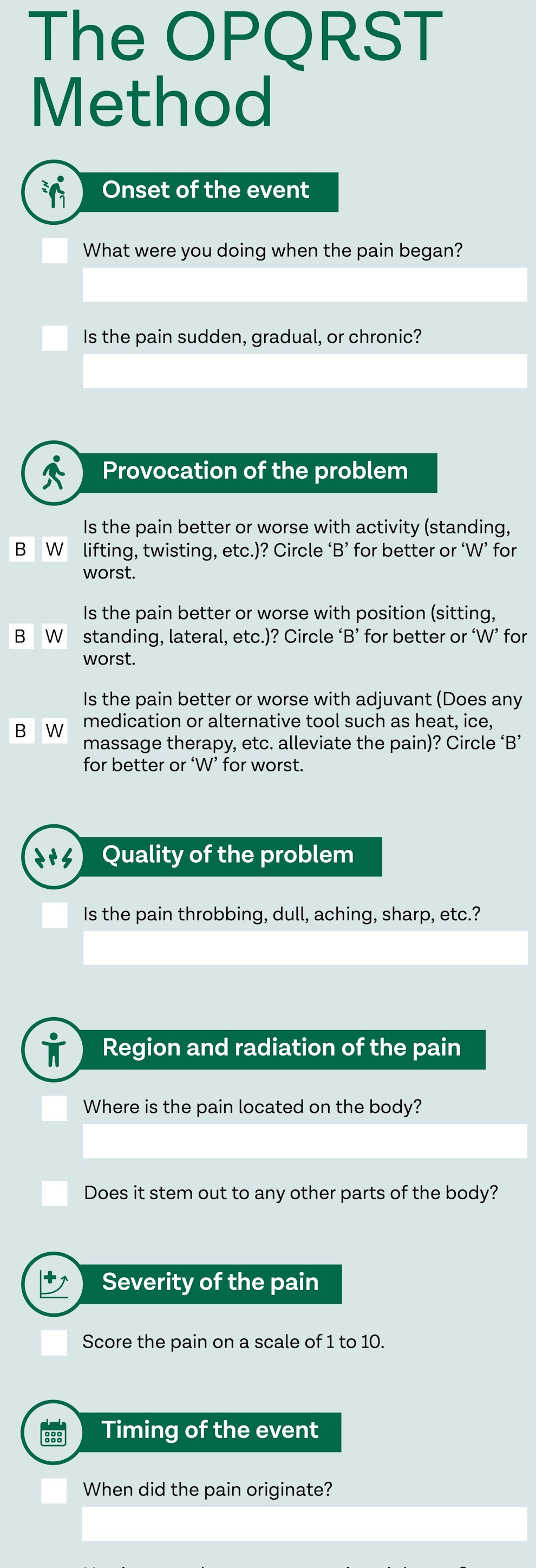
Bring Along Any Health or Fitness Trackers
Any sort of daily tracking mechanism is a good indication of a patient’s daily habits, therefore, they’re perfect tools to bring along with them to their appointment. Examples of daily trackers may include but are not limited to fitness watches, glucometers, blood sugar logs, symptom trackers, blood pressure logs, food logs, etc.
Bring Along Emergency Contact Information
It’s important for your provider to have all pertinent emergency contact information. Write down the name, phone number, address, and email for any family members, friends, attorneys, etc. you find necessary to take care of your healthcare in an emergency situation.
Have a Loved One Join You
At times, doctor’s appointments can be overwhelming. Having a loved one join you is the perfect way to feel supported and comfortable throughout your visit. Not to mention, having a friend or family member in the room allows you to have an extra set of ears listening to what the provider has to say. A ‘ loved one’ can mean a family member, friend, caretaker, health aid, or anyone else in your life that you feel comfortable having involved in your healthcare.
Bring a Note-Taking Device
Whether it’s a physical notepad or the notes section of a smartphone, it’s never a bad idea to bring along a device you can take notes on. When your questions or concerns are being addressed, copy down what the doctor says in response to them. Having notes about what is discussed during the appointment can help you assimilate everything later when reflecting on your doctor’s advice. Furthermore, understanding test results or readings can be complicated or confusing, so taking notes while discussing them can help you to understand the results when looking at them alone.
Things to Focus on During the Appointment
Focus on relaxation.
Many patients experience what is known as ‘ white-coat stress’ in which their blood pressure is raised slightly due to their nerves surrounding seeing a doctor. White-coat stress can impact a patient’s test results and readings, so prior to one’s appointment, it’s good to find ways to relax and relieve tension. Try various activities to calm your nerves before the appointment, such as:
Breathing exercises
Taking a walk
Listening to calming music
Journaling about your thoughts
Sipping on a warm, decaffeinated drink
Regularly participating in yoga, tai chi, or meditation
Herbal remedies with soothing essential oil sprays or lotions
Lastly, one of the most crucial aspects of a doctor/provider relationship is that it should be based on honesty. Your doctor is there to help you and protect your health and wellbeing, therefore, it’s important to be honest with them so they comprehensively understand what and how you’re feeling.
Follow-Up With Scheduling
Before leaving, it’s important to check with your doctor and the office staff about follow-up tasks such as:
Prescription Refills
Outcomes of Test Results
Next Appointment Details
- https://www.nia.nih.gov/health/how-prepare-doctors-appointment
- https://powerfulpatients.org/2016/12/27/15-tips-to-get-the-most-from-your-doctors-visit/
- https://health.clevelandclinic.org/5‑ways-to-make-the-most-of-your-doctors-appointment/
- https://www.inhomecare.com/10-things-to-bring-to-every-doctors-appointment-preparing-to-see-your-doctor/
- https://www.uofmhealth.org/health-library/uz2209
Preparing for a Doctor’s Visit
This infographic provides tips on the best ways to prep for a doctor’s appointment.
Share this page
- Share on Facebook
- Share on Twitter
- Share on LinkedIn
Related articles
Medication adherence tips: 9 ways to stick to your medication schedule.

Annual Physical Exam Checklist: How to Prepare and What To Expect

How To Prepare For a Colonoscopy: Tips For Before, During, & After The Procedure

Related links
- 100+ Important Questions to Ask a Doctor
- When to Switch Doctors: Signs, Tips on Switching, & More
- Top 9 Questions to Ask at Your Annual Physical Exam
- How to Prepare for a Blood Test
Get access to care, right in your neighborhood.
Talk to someone.
We want to make sure you're connected to the right person as quickly as possible.
Call (888) 898‑6762
If you are interested in scheduling an appointment, please call (888) 898‑6762 to speak to an agent.
Send us a message
If you are not a patient, fill out the contact form to help us assist you.

How to use today’s visit to plan for the next one
Pre-visit planning is a way to ensure that your patients get the tests they need — and you get the test results you need — before their next visit. Then you can devote more attention during the visit to interpreting, discussing, and responding to that information.
The process begins at the end of the current visit:
• Identify what labs or other tests the patient should complete before the next visit. Using a “ post-appointment order sheet ” can be helpful, as it allows you to simply check the boxes for any tests the patient needs either the same day, before the next visit, before the annual wellness visit, or before a scheduled procedure.
• Have your staff enter the order and then work with the patient to schedule the tests and the follow-up visit before leaving the office, which will improve compliance. Patients may need to obtain tests several days before the follow-up appointment. However, if your practice uses point-of-care testing or has standard lab testing with a quick turnaround, patients may be able to have their blood drawn 15 minutes to an hour before their follow-up appointment.
Once the patient has completed the pre-visit lab testing, the following steps should occur:
• On the day of the follow-up visit (or the day before), the medical assistant or nurse can help organize the visit for the physician by making sure the results are available and doing a quick review of the patient's record to see what other needs the patient may have during the appointment (an immunization, screening, etc.).
• Conduct a brief “mini-huddle” before the visit. The nurse or medical assistant often learns important medical and social information during patient rooming. A brief “mini-huddle” before the physician meets with the patient can be helpful, ensuring a more efficient, organized visit.
Read the full FPM article: “ Putting Pre-Visit Planning Into Practice .”
- Career management
- Patient care
- Practice management
- RSS ( About RSS )
Other Blogs
- Getting Paid from FPM journal
- AFP Community Blog
- Fresh Perspectives
- In the Trenches
- Leader Voices
Disclaimer: The opinions and views expressed here are those of the authors and do not necessarily represent or reflect the opinions and views of the American Academy of Family Physicians. This blog is not intended to provide medical, financial, or legal advice. All comments are moderated and will be removed if they violate our Terms of Use .
Copyright © 2024 American Academy of Family Physicians. All Rights Reserved.
How to Craft a Perfect Pre-Meeting Email Template
Updated: July 01, 2022
Published: May 02, 2022
As salespeople and professionals, I'm sure you can relate to the sheer number of cold emails I get every hour of every day of the week. With so much noise in our inboxes (not to mention the issue of limited time), there’s a good chance we're not opening all of those emails.

But when I receive a pre-meeting email from a salesperson I’m about to meet, the odds are much better that I’ll open the email and review the content.

In this article we'll discuss:
- The importance of sending a pre-meeting email
- How to write a pre-meeting email
- Pre-meeting email examples and templates

Download Now
What is a pre-meeting email?
A pre-meeting email is an email sent prior to the meeting to help the recipient or prospect prepare ahead of time. Essentially this correspondence sets the tone for what the prospect can expect during the meeting and ensures everyone is on the same page.
While I am more likely to view this person’s email due to our upcoming commitment and prior relationship, I expect more from the email in terms of content.
.png)
5 Free Pre-Sales Meeting Email Templates
Equip your sales team with these voicemail scripts for any occasion.
- Communicate with prospects.
- Iron out your messaging.
- Save time writing.
- Customize to your brand.
You're all set!
Click this link to access this resource at any time.
The Importance of a Pre-Meeting Email
One simple advantage of sending a pre-meeting email is standing out from the competition. You will stay in front of prospects and differentiate yourself if you do some research and get personal.
You also need to keep track of your promises and recommendations throughout the sales process, so that follow-through is carried out with precision, and a pre-meeting email can help you achieve this end. Making business personal and meeting (or better yet, exceeding) expectations are two ways to close more deals.
How to Write an Email for a Meeting
Creating a pre-meeting email template.
You might know that you need to write a pre-meeting email, and you might even know some of the basics of pre-meeting email content, but actually crafting such an important piece of communication doesn’t always come easily.
At the very least, your pre-meeting email should include a reminder confirming the location, time, and date of the meeting. You also should ensure attendees know the purpose of the meeting, along with any reports, pre-reading, or requests for materials a day or two in advance.
Tell us a little about yourself below to gain access.
To create a solid pre-meeting email template, we suggest you follow these steps:

1. Include a specific subject line.
For simplicity, the subject line should include the meeting day and topic. The more attention-grabbing or relevant the subject line is, the more likely your prospect is to open it.
According to Invesp , 47% of email recipients open them based on the subject line. Emails with a personalized subject line were 22% more likely to be opened over those without one.
2. Write a personal greeting.
A simple greeting such as "Hi [name]!" or Hello [name] will suffice.
3. Write a brief reminder paragraph.
This paragraph should cover the purpose of the meeting and what you expect.
For example:
"I’m looking forward to meeting you at [location and time]. As I mentioned during our phone call on [date], I’ll be sharing [product], which relates to your [goal]. We aim to [witty line about your company brand]."
4. Write a brief closing paragraph.
Your closing paragraph can help guide the prospect to a piece of company content. This could be a link to a video, white paper, or some other quality content relating to your meeting.
Offer to provide any other materials that the prospect wants, and make yourself available for questions or feedback.
"You can see a short video about [product] on our website if you’re curious. Feel free to email or call if you have any questions or further needs before we meet on [date and time]."
5. Wrap it up.
Personalizing a pre-meeting email.
Keep in mind that the pre-meeting email template can only get you so far. If you haven’t truly adopted your company’s CRM yet, you need to do so to craft a killer personalized pre-meeting email.
All of the personal information you need about your prospects is in that CRM, and your job as a sales representative becomes much easier when you rely on your company’s existing tools and data when communicating with prospects.
Additionally, remember to include the sales content that matters most to your prospect in your pre-meeting email. If you’re not sure where to find the right content, utilize your company’s sales and marketing productivity tools . Personalizing your pre-meeting email with just the right content could make or break your deal.
Pre-Meeting Email Template
We've covered quite a bit here. Let's get the ball rolling using the HubSpot email template below as a starting point.
1. Standard Pre-Meeting Email Template

Hope you had a nice few days out of the office!
I'm looking forward to our meeting tomorrow. I'd like to walk away having a better understanding of your pain points with global logistics, your team's 2022 goals, and how our international logistics software can help you achieve them.
In the meantime, we just released a new case study with a company I think yours has quite a lot in common with. Here's the link: [Insert link].
Let me know if you have any questions. Otherwise, looking forward to connecting tomorrow at 11:00 AM ET. Hope you're surviving the post-vacation sluggishness!
Regards, Meg

What we like:
This example kept things short, concise, and direct. They've reminded the prospect of the meeting they both agreed to, provided them with a brief outline of what will be discussed, and provided value to them in the form of a relevant content offer.
2. Friendly Reminder Pre-Meeting Email Template
Sometimes you may just want to send a quick follow-up to confirm your meeting. In this instance, you can use the template below.
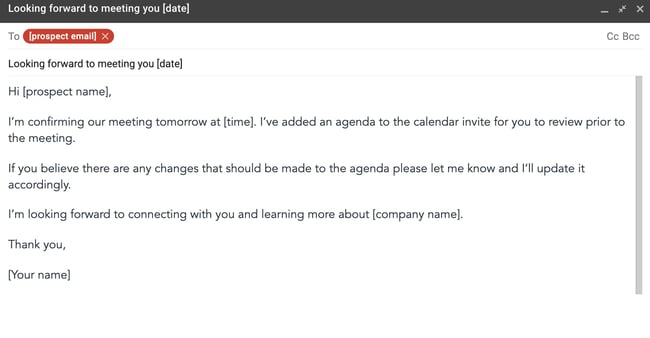
Hi Candice,
I’m confirming our meeting tomorrow at 2:30 PM. I’ve added an agenda to the calendar invite for you to review prior to the meeting.
If you believe there are any changes that should be made to the agenda please let me know and I’ll update it accordingly.
I’m looking forward to connecting with you and learning more about TriStar.
This email is short and sweet, confirming the date and time of the meeting, while also giving the recipient room to change the meeting date if the one listed is no longer feasible.
The addition of the agenda ensures that everyone comes to the meeting prepared and ready to discuss ideas.
3. Preparing a Prospect
Sometimes you may want to give your prospect materials to review prior to meeting to give them the opportunity to brainstorm and come up with questions. In this case, the email template below will be of good use.
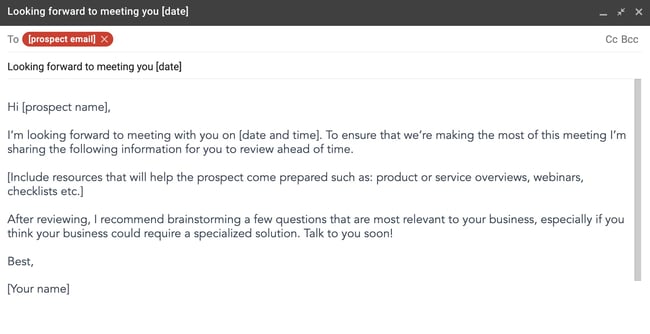
I’m looking forward to meeting with you this Thursday (4/8) at 10 AM. To ensure that we’re making the most of this meeting I’m sharing the following information for you to review ahead of time.
- Product and Service Overview
- Product Demo
After reviewing, I recommend brainstorming a few questions that are most relevant to your business, especially if you think your business could require a specialized solution. Talk to you soon!
This email gives the prospect everything they need to know prior to the meeting to ensure they're making the best use of their time. By giving the prospect materials like a demo or service overview ahead of time, they can digest the information on their own time and start to visualize how your product can provide value to their business. It also gives them time to prepare any questions they have ahead of time.
4. Confirming Attendees
While you may have only one contact at the prospect's company, others may want to attend the meeting. Use the template below to make sure all attendees get the invite.
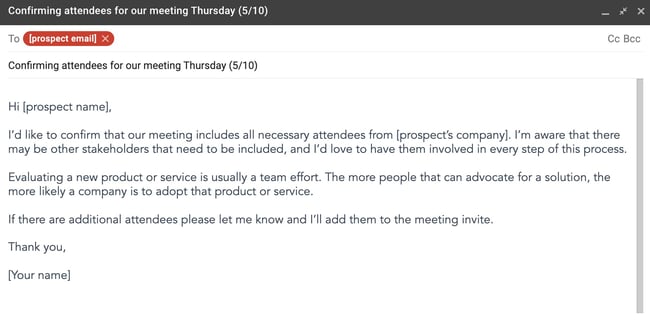
Hello Robert,
I’d like to confirm that our meeting includes all necessary attendees from ClearPoint. I’m aware that there may be other stakeholders that need to be included, and I’d love to have them involved in every step of this process.
Evaluating a new product or service is usually a team effort. The more people that can advocate for a solution, the more likely a company is to adopt that product or service.
If there are more guests you'd like to attend, please let me know and I’ll add them to the meeting invite.
This example displays the sales rep's understanding of the importance of having all stakeholders involved in the decision-making process.
Giving prospects the opportunity to add more guests will get more stakeholders involved and give you access to other contacts within the company.
Pre-Meeting Emails are Worth the Extra Step
Sending a pre-meeting email might seem formal, but it's a great way to ensure your plans go smoothly. Additionally sending an email ahead of time adds a human touch to your meeting instead of it being a faceless hold on your prospect's calendar.
Communication and relationship-building are what selling is all about, but you can't do either if you never meet.
Editor's note: This post was originally published on August 1, 2015 and has been updated for comprehensiveness.
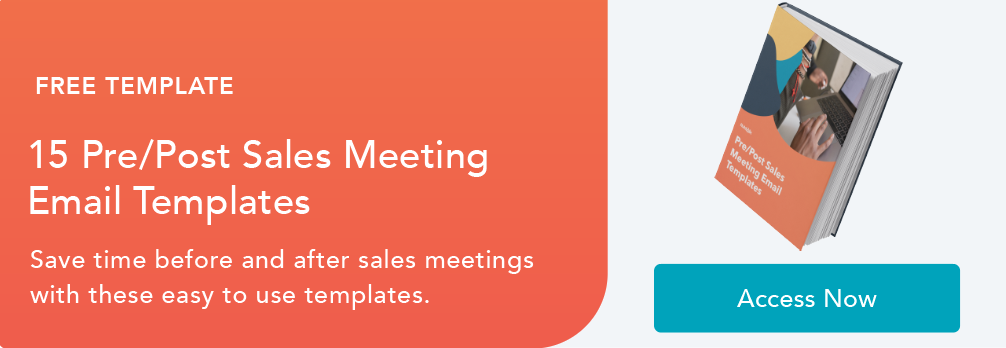
Don't forget to share this post!
Related articles.

How to Reschedule a Meeting Professionally in 2024
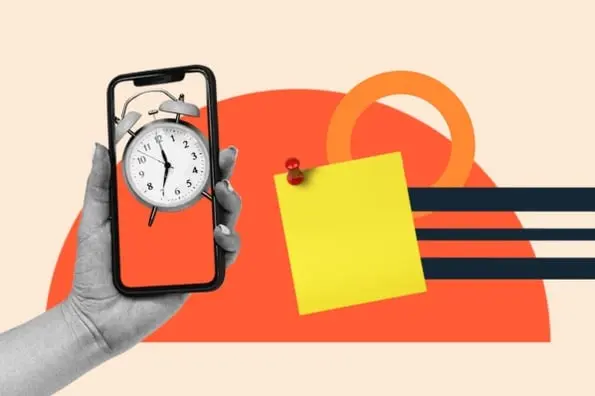
The Best 24 Appointment Scheduling Apps and Booking Software
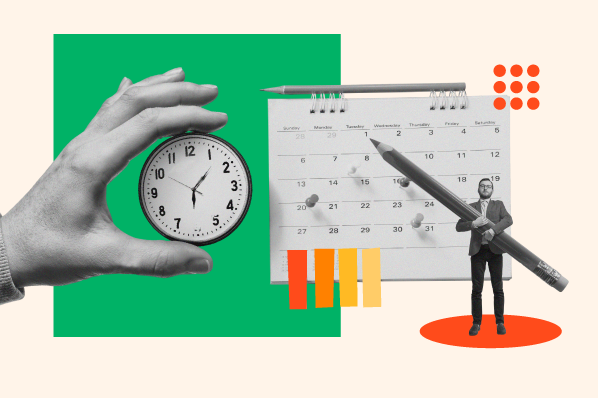
How to Get an Appointment With Anyone in 3 Simple Steps
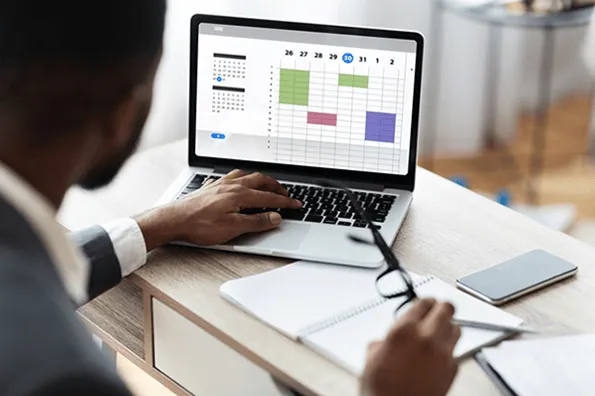
How to Find a Meeting Time That Works for Everyone (Plus Tools)

15 Best Event Scheduling Polls & Meeting Survey Tools for Your Team

The Sales Huddle: 9 Ideas to Drive Your Next Team Meeting

Why B2B Appointment Setting Should Be Part Of Your Sales Strategy

Sales Meeting Agenda: The Master Tip for Closing More Deals

Face-to-Face Meetings: The Ultimate Guide

The Best Days and Times for Sales Meetings, According to New Data
Use these templates to easily and quickly craft emails to send before and after sales meetings.
Powerful and easy-to-use sales software that drives productivity, enables customer connection, and supports growing sales orgs
Should A Physician Pre-Chart For Outpatient Visits?
- Post author By James Allen, MD
- Post date November 28, 2018

There is a subtle difference between inpatient and outpatient medical practice that nobody ever talks about… time management. With inpatient practice, you see patients at your own pace during rounds and if you want to stop for a moment to have a cup of coffee or speak with a colleague, it doesn’t disrupt your workday. But with outpatient practice, you can work leisurely at your own pace before office hours and after office hours but during office hours, you are in a constant state of demand for time efficiency.
In my own practice, my office hours come in 4-hour blocks, either 8:00 AM to 12:00 noon or 1:00 PM to 5:00 PM. During those blocks, I schedule 15 minutes for return visits and 45 minutes for new patient visits – every minute is scheduled and the only way that there is a break is if one of the patients doesn’t show up for their appointment. During that 4-hour block, I have nurses, schedulers, and registration staff who all need to be working in order for the office to function in a financially viable way. But for them to stay constantly busy, I have to be constantly busy.

So 5 months ago, I tried a different approach, pre-charting for my outpatient visits. The day before my office hours, I start my progress note for each patient by selecting the appropriate return visit note template (I have different templates for different diseases: one for interstitial lung disease, one for asthma, one for COPD, etc.). I pre-populate any new test results and pre-populate my final “impression” by pasting in the diagnoses that I manage for that particular patient from their previous note. For new patients, I insert the appropriate new patient template (again, I have different templates for different pulmonary conditions) and pre-populate the note with any test results, radiograph image review, pulmonary function tests, etc. that are available for that patient, either from our medical center or from other hospitals that I can access through the “CareEverywhere” function in our EMR (we use Epic). As a result, I spend about an hour prior to each 4-hour outpatient block pre-charting, sometimes longer if I have a new patient with a lot of records that require reviewing. After 5 months, I’ve found that there are advantages and disadvantages:
Advantages:
- I am less likely to get behind on my schedule and so my patients are spending less time in the waiting room.
- I have more time to spend just talking with my patients since I am not trying to furiously type into the EMR as much when I am in the exam room with the patient. As a consequence, I find that I actually enjoy my time in the outpatient clinic a lot more than I used to.
- I anticipate improvement in two of the CGCAHPS survey questions: During this visit did this provider seem to know the important information about your medical history? and During this visit, did this provider have your medical records?
- I finish the day’s work earlier because I do less charting at the end of the day by front-loading all of that charting before office hours.
- I have now started billing CPT code 99358 about 2-4 times a week. This code pays you for review of medical records prior to seeing the patient in the office, as long as you spend at least 31 minutes doing the review. In my own outpatient practice, most of my patients have already had pretty extensive evaluations and in about half of the new patients, I spend > 30 minutes sifting through office notes, lab tests, cardiovascular tests, chest CT images, pulmonary function tests, etc. This pays 3.16 RVUs (about $114 in Medicare reimbursement) and I now find myself getting paid for the work that I was previously doing for free. And this adds up… I estimate that my clinical receipts will increase about $13,000 per year from this CPT, alone.
- I have x-rays available when I see the patient. Most of my patients are sent to me from physicians at other hospital systems and so most of their chest x-rays and CT scan images are not in our hospital’s computer system. By pre-charting, I have been able to identify where those radiographs were done so that my office staff can contact that hospital’s radiology department and have the images sent over the internet before I see the patient – in the past, I often had to schedule a second visit with the patient just to go over x-ray images that I requested after I first saw the patient for an initial consultation.
- I have been able to do a “huddle” with the nurses just before the start of office hours to let them know about anything special that they will need to do to prepare for each patient’s visit.
Disadvantages:
- In the past, I defined my workday as being complete when I finished all of the work for the patients that I saw on that particular day and the administrative duties I had for that day. Because pre-charting is often relegated to the last thing that I do each day (since it is usually the least urgent), pre-charting becomes the task that keeps me at work an hour longer each day and so I now negatively associate it with being the thing that steals my time away from my family in the evening.
- I often have residents and fellows in the office with me. I worry that by doing the pre-charting, I am detracting from their experience of independently analyzing the patient. Personally, I believe that the trainees learn a lot about how to comb through old records for diagnostic clues efficiently by actually doing it themselves and when I pre-chart, I am depriving them of this opportunity.
- I’ve created this nagging sense that I am becoming obsessive-compulsive.

November 28, 2018
By James Allen, MD
I am a Professor Emeritus of Internal Medicine at the Ohio State University and former Medical Director of Ohio State University East Hospital
- Recommended

Should you have a precolonoscopy visit? The answers may surprise you.
Your primary care doctor has been nagging you for years. Your wife and brother seem to be in on the scheme too. Every once and a while one of your coworkers even says (with a chuckle) “C’mon Bob, you’re fifty-seven, you really need to get it done!”
“OK, enough,” you finally say, “I’ll go for a colonoscopy!” So at your next visit you ask your primary doctor how to set it up and he gives you the name of a local gastroenterologist to call. After a week or two, you finally build up the courage to call the office and say proudly, “Hi, I want to schedule a colonoscopy!”
“Have you seen the doctor already sir?” asks the receptionist.
You answer, “No, but Dr. Jones is my primary, he can send over all my records. I just need a colonoscopy.”
“You need to make an appointment to see the doctor first sir, then we can schedule the colonoscopy,” says the receptionist.
You think to yourself, “Seriously? What is the point of seeing the doctor first … so he can get more of my copays? What is there to talk about? Why can’t I just make the appointment for the test? Now I have to take more time off from work too. How did I let myself get talked into this?”
Apparently, researchers at Johns Hopkins University School of Medicine had similar questions, and tried to answer them in a study published in the Journal of the American Medical Association this month. The authors looked at insurance claims for over 842,000 screening and surveillance colonoscopies done on patients 50 to 64 years of age, and concluded that a precolonoscopy office visit resulted in a mean payment of $123 by insurers. If you average this across all of the patients in the study, this results in an additional $36 per colonoscopy performed.
This is interesting, since the majority of patients in this study (about 70 percent) did not have precolonoscopy visits; instead, an “open-access” model was used. Open-access refers to a program where a primary care doctor can directly refer pre-selected patients for colonoscopy without the patient having to meet the gastroenterologist first. Usually, this consists of filling out a checklist to make sure that the patient is truly only in need of a screening colonoscopy. That is, the patient must be asymptomatic, with no family history of colon cancer, and without several key signs/symptoms (e.g., rectal bleeding, iron-deficiency anemia, abdominal pain, chronic diarrhea, etc.)
In open-access colonoscopy, the primary care doctor takes on an additional paperwork and administrative burden in favor of saving the health care system $123 per colonoscopy. One might think, “Fine, that only adds about one minute of the doctors time.”
However, in reality, the patient will likely have some questions for the referring doctor: Questions about the colonoscopy, about the gastroenterologist, about insurance coverage, about diet, about bowel prep, about what to do with their medications (especially aspirin and other blood thinners), about the risks, about getting to the endoscopy suite, etc. All of these questions will take additional time to answer and impose an additional workload on the already overburdened primary care doctor and his or her staff. Alternatively, given the above constraints, these questions may not get answered at all.
Here in Long Island, NY where I practice, it seems to be the norm to have a precolonoscopy visit. This visit serves several important purposes in my mind: I can meet the patient, take a history, and make sure that they actually need a screening colonoscopy. I can answer all of the above questions in more detail than the primary doctor can. I also get to give them my basic talk about the purpose of a colonoscopy, how and why we remove polyps, the importance of good bowel prep and how to do it, and the small associated risks of a colonoscopy. We can talk about what to do with medications, and where to arrive on the day of the test, and parking, and all those seemingly small details that can make a patient stressed-out about the test for no good reason.
I can also make sure that there are no other issues going on with the patient. A significant number of screening colonoscopy patients actually turn out to have other complaints, most commonly rectal bleeding, weight loss, chronic constipation or diarrhea. Since these are often embarrassing things for patients to volunteer, and since primary care doctors don’t have the time to spend their entire visit discussing the GI tract, these complaints often never make it out of the patient’s mouth. Many patients, realizing that something might be wrong, will instead ask for a colonoscopy rather than saying “I’ve been losing weight and seeing blood in the toilet for three months.” When asked directly at the time of their precolonoscopy visit, the truth usually comes out.
There is another benefit to the precolonoscopy visit that is not talked about in studies: It is the patient’s time to interview me too! Am I someone that they feel comfortable with? Do I seem to know what I am doing? Is the office clean? Do my hands shake? What if I have to give them bad news; do they trust me to take the next steps in their care? I find that for many patients the words colonoscopy and anxiety seem to go hand-in-hand. Hopefully by meeting me ahead of time, most of this anxiety can be eliminated.
Here are some other points I think should be included in the next study of precolonoscopy office visits vs. open-access colonoscopy:
- How many patients actually follow through with the procedure?
- What is the anxiety level of the patient?
- How well does the patient understand the purpose of the test?
- Can the patient articulate the risks of the procedure that they signed up for?
- What is the quality of the bowel prep between the groups?
- Adenoma detection rate?
- Number of procedures that need to be repeated due to poor prep or other factors?
I’m not saying that open-access is bad. In fact, it can probably be a good cost- and time-saving measure for selected patients (namely motivated, health-literate patients without any major medical problems). However, we must remember that sacrificing cost usually also sacrifices quality. For an average of $123, a patient can be better informed, less anxious, and better prepared for having a well-lubricated 6-foot-long flexible tube gently and expertly stuck where the sun don’t shine, all in the name of preventing colon cancer. Isn’t that worth paying for?
Frederick Gandolfo is a gastroenterologist who blogs at Retroflexions .
Image credit: Shutterstock.com

10 simple facts about Zika virus

Justice Scalia: Why didn't they perform an autopsy?

Tagged as: Gastroenterology
More by Frederick Gandolfo, MD

White coats should no longer be worn by physicians
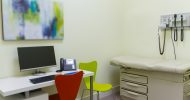
Before starting your own practice, do these 3 things first

Don’t forget this common trigger of cyclic vomiting syndrome
Related posts.

A shortage of Kayexalate leads to an ER visit

A surprise pregnancy in medical school

Let’s end surprise billing without a Trojan Horse
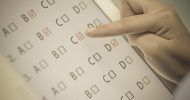
USMLE Step 1 tips that may surprise you

Compromise vs. greed in ending surprise medical bills
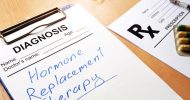
Hormone replacement therapy is still linked to cancer
More in conditions.

Growing up with diabetes

Health care in turmoil: costs, shortages, and pandemic strains

Mental health treatment plan goals: Setting providers and patients up for success
Virtual rehabilitation of central sensitization syndromes.

Science supports it and patients want it: Bringing whole-person care to cancer treatment

Empowering patients to discuss sexual health
Most popular.

Should we teach business literacy to medical trainees?

From struggle to success: inspiring tales of resilience

Bridging care and culture: a Filipino doctor’s journey in direct primary care

An internal medicine doctor’s appreciation of a patient’s name

Past 6 Months

We are all concierge doctors now

Your A+ in anatomy and physiology won’t improve the American health care system

Medicine’s struggle for inclusivity

Venture-backed telemental health care companies are creating a new opioid epidemic

Medicine is not apolitical: Your vote dictates your ability to practice medicine

Elite access vs. public scrutiny: Medication disparities exposed
Recent posts.
![Navigating Match Day emotions [PODCAST] prior to the visit](https://www.kevinmd.com/wp-content/uploads/Navigating-Match-Day-emotions-190x100.jpg)
Navigating Match Day emotions [PODCAST]

Revolutionizing medicine with AlphaFold 3: the new frontier in biomedical research

Why you should take a closer look at occupational and environmental medicine
![Telemental health’s warning signs [PODCAST] prior to the visit](https://www.kevinmd.com/wp-content/uploads/Telemental-healths-warning-signs-190x100.jpg)
Telemental health’s warning signs [PODCAST]
Subscribe to kevinmd and never miss a story.
Get free updates delivered free to your inbox.
Find jobs at Careers by KevinMD.com
Search thousands of physician, PA, NP, and CRNA jobs now.
CME Spotlights
Should you have a precolonoscopy visit? The answers may surprise you. 5 comments
Comments are moderated before they are published. Please read the comment policy .
Body camera video shows fatal shooting of Black airman by Florida deputy in apartment doorway
Body camera video shows a Florida sheriff’s deputy announced himself as law enforcement just before fatally shooting a Black U.S. Air Force airman inside his apartment in the state’s Panhandle
FORT WALTON BEACH, Fla. — A Florida sheriff released body camera video Thursday showing a deputy outside an apartment door and firing immediately when it was opened by a Black man carrying a handgun pointed downward, a killing the family denounced as “unjustifiable.”
Okaloosa County Sheriff Eric Aden presented the video hours after the family of U.S. Air Force Senior Airman Roger Fortson and their attorneys held a news conference in which they disputed that the deputy acted in self-defense. Aden rejected assertions made by civil rights attorney Ben Crump, who is representing Fortson’s family, that the deputy had gone to the wrong apartment, covered the door’s peephole and did not announce himself.
The video shows the deputy arriving at a Fort Walton Beach apartment building on May 3 and speaking to a woman outside who described someone hearing an argument. The deputy then went up an elevator and walked down an outdoor hallway.
The video shows the deputy banging on the door and stepping aside, seemingly out of view of the door. Twice he shouted: “Sheriff’s office! Open the door!”
Fortson opened the door and could be seen holding what appeared to be handgun pointed down toward the floor. The deputy shouted, “Step back!” and fired off shots. He then shouted, “Drop the gun! Drop the gun!”
“It’s over there,” Fortson said.
“Drop the gun!” the deputy yelled back.
“I don’t have it,” Fortson said, lying on the ground.
The deputy then called paramedics on his radio.
The sheriff’s office has declined to identify the responding deputy or his race. The deputy was placed on administrative leave pending an investigation.
Crump released a statement later noting that the officer did not tell Fortson to drop his gun before shooting “multiple times within a split second of the door being opened.”
“We remain adamant that the police had the wrong apartment as Roger was on the phone with his girlfriend for a substantial amount of time leading up to the shooting, and no one else was in the apartment,” the statement said.
Crump also told reporters earlier that Fortson was talking to his girlfriend on FaceTime and that he grabbed his gun because he heard someone outside his apartment. He said that the deputy burst into the apartment, citing the account of the girlfriend, who has not yet been identified.
“The girlfriend acknowledges that even though she initially thought the door was forced open by the police that she stands by her emotional recollection of what happened,” Crump’s later statement said.
In a clip from the FaceTime video captured by Fortson’s cellphone, the airman can be heard groaning and saying, “I can’t breathe.” A deputy can be heard yelling back at him, “Stop moving!” The phone is pointed at the ceiling and does not show what is going on in the apartment.
Aden said he had met with the family Thursday and extended his deepest condolences.
“This result is one we never hope to encounter,” Aden said. “These investigations take time, but I want to assure you that we are not hiding or attempting to cover anything up.”
Officials have said the Florida Department of Law Enforcement is investigating. FDLE spokeswoman Gretl Plessinger told The Associated Press on Wednesday that it is unlikely the agency will have any further comment until the investigation is complete.
The sheriff said the probe was being handled as a criminal investigation and that no determination had yet been made on whether the deputy’s actions were justified or not. However, the initial news release from the sheriff’s office that described the shooting said that the deputy “reacted in self-defense after he encountered a 23-year-old man armed with a gun.”
Fortson’s mother, Chantemekki Fortson, walked into the morning news conference with Crump holding a framed portrait of her son in his dress uniform. She burst into tears as Crump spoke about her son’s death.
“My baby was shot up,” she said.
Crump called the shooting “an unjustifiable killing.”
“For whatever reason, they thought he was a bad guy, but he was a good guy. He was a great guy. He was an exceptional guy,” Crump said. “They took a patriot from us.”
Crump said Fortson, originally from Atlanta, was shot six times.
Fortson enlisted in the Air Force after graduating high school, Crump said. He was based at the Special Operations Wing at Hurlburt Field. As a special missions aviator, one of his roles was to load the gunship’s cannons during missions.
Crump, based in Tallahassee, Florida, has been involved in multiple high-profile cases of Black people in fatal encounters with law enforcement and vigilantes, including those of Ahmaud Arbery , Trayvon Martin , Tyre Nichols , George Floyd and Breonna Taylor , who was also killed in her home during a no-knock police raid that targeted her ex-boyfriend in 2020.
Fortson’s death draws striking similarities to other Black people killed in recent years by police in their homes.
In 2018, a white Dallas police officer fatally shot Botham Jean, who was unarmed, after mistaking his apartment for her own. Amber Guyger, the former officer, was convicted of murder and was sentenced to 10 years in prison.
In 2019, a white Fort Worth, Texas, officer fatally shot Atatiana Jefferson through a rear window of her home after responding to a nonemergency call reporting that Jefferson’s front door was open. Aaron Dean, the former officer, was convicted of manslaughter and sentenced to nearly 12 years in prison.
Crump represented families in both cases as part of his effort to force accountability for the killings of Black people at the hands of police.
Schneider reported from Orlando, Fla.
This story has been updated to correct the spelling of the name of Fortson’s mother to Chantemekki instead of Chantimekki and to reflect that some of the cases Crump has been involved with were encounters with vigilantes, not just law enforcement.

An official website of the United States government Here's how you know
Official websites use .gov A .gov website belongs to an official government organization in the United States.
Secure .gov websites use HTTPS A lock ( Lock A locked padlock ) or https:// means you’ve safely connected to the .gov website. Share sensitive information only on official, secure websites.
Tribal HPP Program
The Tribal High Priority Projects (Tribal HPP) Program , as established under 23 U.S.C. 202, is a nationwide priority program for:
- An Indian Tribe or governmental subdivision of an Indian Tribe whose annual allocation of funding under the Tribal Transportation Program is insufficient to complete the highest priority project of the Indian Tribe or governmental subdivision of an Indian Tribe; or
- Any Indian Tribe that has an emergency or disaster with respect to a transportation facility included on the national inventory of Tribal transportation facilities under section 202(b)(1) of Title 23, United States Code.
To receive updates about the Tribal HPP Program, subscribe to the Office of Tribal Transportation Mailing List .
Bipartisan Infrastructure Law (BIL)
On November 15, 2021, President Biden signed the Infrastructure Investment and Jobs Act (IIJA) (Public Law 117-58, also known as the Bipartisan Infrastructure Law ) into law. The Bipartisan Infrastructure Law is the largest long-term investment in our infrastructure and economy in our Nation s history. Each year BIL provides $9,000,000 of the available TTP funds are set aside for the Tribal HPP Program. In addition to the $9,000,000 set aside, there is authorized to be appropriated $30,000,000 out of the general fund of the Treasury for each fiscal years 2022 through 2026, if Congress passes this funding in their legislation.
Resources for Preparing a Tribal HPP Program Application
Any time during the year, the Tribe can submit an application package for Tribal HPP Program funding. On January 31, the applications received will be reviewed for eligibility, evaluated, and ranked for funding. Applications submitted after January 31 will be collected for the next fiscal year funding cycle.

The application form shall be completed and submitted to your FHWA or BIA Point of Contact. The following documents may be used by the Tribe to assemble the application package:
Priority Projects
- Tribal HPP Program Priority Project (Checklist for Tribe).pdf (163.54 KB)
- Application Form
- Application Form Instructions
Emergency or Disaster Projects
- Checklist for Tribe
- Application Form Instructions
A webinar for prospective applicants was held on October 11, 2023 to review the funding opportunity and application process. Access to the webinar can be found here .
Tribal HPP Program Frequently Asked Questions
Link to FAQs
Funded Projects
A webinar for awardees was held to review the post-award requirements, roles, and responsibilities. A recording of the webinar can be found here .
Prior Year Tribal HPP Program Funding Priority List:
- FY 2022-2023
- Final Funding Priority List FY 2024
Tribal HPP Program History
Prior to bil.
The Indian Reservation Roads High Priority Projects Program (IRRHPP) was created through negotiated rulemaking and documented at 25 CFR 170 (July 19, 2004). Under these regulations, the IRRHPP was a set-aside from the Indian Reservation Roads Program (IRR) and was funded from 2005 through 2012. Applications were ranked by a committee comprised of BIA, FHWA and tribal participants using the scoring matrix specified in the regulations. In 2012, $28,533,502 was awarded to Tribes through the IRRHPP.
The Tribal HPP Program was enacted and codified in 23 U.S.C. 202, through Public Law 112-141 (MAP-21 §1123 dated July 6, 2012) and a fact sheet was developed ( https://www.fhwa.dot.gov/map21/factsheets/thpp.cfm ). The Tribal HPP Program was modeled after the former IRRHPP in 25 CFR 170 (July 19, 2004) but MAP-21 changed the funding from a TTP set-aside to an authorized appropriation of $30 million per year from the General Fund. Although MAP-21 authorized the program, there were no appropriations for the program under MAP-21 or the FAST Act.
2010 IRRPCC Recommendations to BIA High Priority Project Team for Eligibility Requirements click here .
Contact Information
Please contact the Tribal HPP Program Manager, Blane Kunihisa at [email protected] or 360-619-7814 if you have any program questions. Others on the Tribal HPP Program Administration team include:
- Miles Brookes, FHWA
- Robert Frazier, BIADOT
- Jeff Harman, BIA Alaska Region
- Demery Bill, BIA Pacific Region
- Cambridge Dictionary +Plus
Meaning of prior to something in English
Prior to something.
- before Try to arrive before the start of the meeting.
- prior to All utensils should be washed prior to use.
- in advance of Call in advance of your visit to see if you'll need a parking reservation.
- ahead of My sister is arriving ahead of me to do the shopping for the dinner.
- by Make sure you're back by midnight.
Translations of prior to something
Get a quick, free translation!

Word of the Day
Your browser doesn't support HTML5 audio
relating to or caused by an earthquake

Varied and diverse (Talking about differences, Part 1)

Learn more with +Plus
- Recent and Recommended {{#preferredDictionaries}} {{name}} {{/preferredDictionaries}}
- Definitions Clear explanations of natural written and spoken English English Learner’s Dictionary Essential British English Essential American English
- Grammar and thesaurus Usage explanations of natural written and spoken English Grammar Thesaurus
- Pronunciation British and American pronunciations with audio English Pronunciation
- English–Chinese (Simplified) Chinese (Simplified)–English
- English–Chinese (Traditional) Chinese (Traditional)–English
- English–Dutch Dutch–English
- English–French French–English
- English–German German–English
- English–Indonesian Indonesian–English
- English–Italian Italian–English
- English–Japanese Japanese–English
- English–Norwegian Norwegian–English
- English–Polish Polish–English
- English–Portuguese Portuguese–English
- English–Spanish Spanish–English
- English–Swedish Swedish–English
- Dictionary +Plus Word Lists
- English Phrase
- Translations
- All translations
To add prior to something to a word list please sign up or log in.
Add prior to something to one of your lists below, or create a new one.
{{message}}
Something went wrong.
There was a problem sending your report.
- All Services
- Elections Elections collapsed link
- License & ID License & ID collapsed link
- Vehicle Vehicle collapsed link
- Industry Services Industry Services collapsed link
- Resources Resources collapsed link
- Notary Notary collapsed link
- Languages Languages collapsed link
- Elections resources
- Your voter information (Michigan.gov/Vote)
- How to vote in Michigan
- Election results and data
- Election security in Michigan
- Ballot access
- Election administrator information
- Be a poll worker
- Board of State Canvassers
- Michigan Independent Citizens Redistricting Commission
- Voter education resources
- Register to vote
How do I...
- Schedule an office visit
- Renew my tabs
- Change my address
- Purchase a copy of my driving record
- Correct my name
- Renew my license or ID
- Apply for or renew a disability parking placard
- Apply for or renew a CDL
- Order a license plate
- Order a duplicate title
The web Browser you are currently using is unsupported, and some features of this site may not work as intended. Please update to a modern browser such as Chrome, Firefox or Edge to experience all features Michigan.gov has to offer.
- Google Chrome
- Microsoft Edge
Early voting in Michigan
Michigan voters have the right to cast a ballot early and in person at an early voting site before Election Day.
Early voting will be available beginning with the presidential primary in 2024 and every statewide and federal election thereafter.
Check back for additional updates on early voting requirements and information.
Learn more about early voting in Michigan
What is early voting, who can vote early, where can i vote early, when can i vote early, how do i vote early, is early voting secure, how is early voting managed.

In November 2022, Michigan voters overwhelmingly approved a constitutional amendment that gives voters the right to vote early and in person at early voting sites before statewide and federal elections. Communities may also choose to provide early voting for local elections.
Early voting allows a voter to cast a ballot before Election Day, in an experience similar to voting on Election Day.
During the early voting period, voters are issued a ballot and can then insert their ballot directly into a tabulator at their early voting site.
Both early in-person voting and absentee voting allow voters to cast a ballot prior to Election Day. However, there are key differences between the two methods of voting.
Early voting allows voters to cast a ballot similar to how they would do so at a polling place on Election Day. Voters are issued a ballot and can personally insert it into the tabulator at their early voting site.
Absentee voting allows voters to request a ballot by mail or in person at their local clerk’s office. Voters can complete their absentee ballot at home or at their local clerk’s office and submit it in an envelope by mail, in person, or by drop box. After an absentee ballot is received by the local clerk, the voter’s absentee ballot is processed and tabulated by their local clerk.
Absentee voters also have more flexibility to “spoil” their ballot, or change their vote, after it has been submitted.
Learn more about absentee voting.
Yes. In fact, many states have some form of early voting. This includes states with smaller populations such as Delaware, North Dakota, and West Virginia as well as larger states like Florida, Illinois, New York, and Texas.
For more information, visit the National Conference of State Legislature’s brief on early in-person voting .

Any registered voter in Michigan has the right to vote early in person at an early voting site for statewide and federal elections in which they are eligible.
Voters in Michigan can register to vote up to and on Election Day, including during the early voting period.
Learn more about voter registration.
It is recommended that voters be registered to vote at their current address prior to visiting an early voting site. Voter registration is available online at Michigan.gov/Vote. Within 14 days of an election, voters must visit their local clerk’s office and provide proof of residency to register to vote.
Early voting sites do not offer voter registration. However, if an early voting site is located at a clerk’s office or satellite office, voters may register to vote on site at the clerk’s office, and cast a ballot at the early voting site. Contact your local clerk’s office or visit their website to learn more.
Learn more about voter registration .
Find your clerk's information .
No. Voters should remember to bring an acceptable form of photo identification to an early voting site or to the polls on Election Day. However, a photo ID is not required to cast a ballot. Voters without a photo ID, or voters who forgot to bring their photo ID, can still vote after signing an Affidavit of Voter Not in Possession of Picture Identification.
Learn more about photo ID and voting.
All voters, including voters with disabilities, have the right to vote in person at an early voting site, at a polling place, or by using a standard or accessible absentee ballot.
Early voting sites feature at least one Voter Assist Terminal (VAT), a ballot-marking device that can be used by any voter. VATs also provide assistive tools for voters with visual, hearing, mobility, or other disabilities.
Accessible curbside voting is also available at early voting sites. Voters may contact their local election clerk to request curbside voting. Voters may need to send someone into the early voting site to request curbside voting on their behalf. An election official will then bring the ballot outside for the voter to complete.
Look up voter assist terminal equipment by county .
Learn more about accessible voting.

Voters can visit an early voting site in their area to cast a ballot in person during the early voting period.
Voters can look up their assigned early voting site(s) up to 60 days prior to Election Day at Michigan.gov/Vote .
An early voting site is like a polling place where voters can cast a ballot prior to Election Day, during the early voting period. Voters from more than one precinct, city, or township may be assigned to a single, shared early voting site.
Voters may only cast a ballot at their assigned early voting site(s). They can look up their assigned early voting site(s) up to 60 days prior to Election Day at Michigan.gov/Vote .
Some voters may only have one assigned early voting site, while others may have several locations to choose from.
At least one early voting site must be available to all voters in every city and township.
Local clerks select the number and location of early voting sites that work best for their community by examining the area’s population density, site accessibility, and expected voter turnout.
Local clerks may also partner with other cities and townships, or their county, to run an early voting site together.

The early voting period takes place for a minimum of nine consecutive days, ending on the Sunday before an election. Communities may decide to provide additional days of early voting, up to 29 days total.
Early voting sites must be open for at least eight hours each day during the early voting period.
Early voting is offered for all statewide and federal elections. Communities may also choose to provide early voting for local elections.
Early voting site locations, dates, and hours are available 60 days prior to Election Day at Michigan.gov/Vote .
Early voting will be available beginning with the 2024 presidential primary. It will be available for the 2024 August primary election, the November 2024 general election, and every statewide and federal election thereafter.
The early voting period begins the second Saturday prior to Election Day and ends the Sunday before an election. However, communities may decide to provide additional days of early voting. Under state law, communities can offer up to 29 days of early voting.
Early voting is provided for local elections (non-federal or state elections) at the discretion of the local clerk. Early voting site locations, dates, and hours are available up to 60 days prior to Election Day at Michigan.gov/Vote . You can also contact your local clerk’s office for more information.
Find your local clerk’s information .
Yes. During each day of the early voting period, eligible voters waiting in line when an early voting site closes have the right to stay in line and cast a ballot.

The following steps can help you make a plan to vote early.
☑ Make sure you are registered to vote, and that your voter registration address is up to date. Check your status or register online .
☑ Within 60 days of a statewide or federal election, lookup your early voting site information at Michigan.gov/Vote .
☑ Review a sample ballot online at Michigan.gov/Vote .
☑ Visit your early voting site during the early voting period to cast a ballot.
Yes. Voters can request an absentee ballot and submit it prior to Election Day by mail, in person at their local clerk’s office, or by drop box.
Voters who no longer wish to use their absentee ballot and who would prefer to vote early in person should bring their absentee ballot to surrender at their early voting site. After surrendering their absentee ballot, a new ballot is issued to complete and submit on-site.
Beginning in the February 27 Presidential Primary election, voters can bring their absentee ballots to an early voting site to insert into a tabulator. The election inspector must verify that voters with absentee ballots are in the correct location and that they have the correct ballot number. Once the election inspector has confirmed this information, the voter can insert a completed absentee ballot into the tabulator, just like at a polling place on Election Day.
Learn more about absentee voting .
Yes, every voter has the right to a secret ballot.
At early voting sites, voters insert their completed ballot into a tabulator, just like at a polling place on Election Day. To protect voter privacy, once a ballot has been inserted into a tabulator, it cannot be traced back to an individual voter.
Ballots inserted in the tabulator are sealed in secure containers each night during the early voting period. After polls close on Election Day, all ballots submitted at an early voting site are totaled and reported, along with the vote totals from absentee and Election Day ballots.
The use of cameras and recording devices in early voting sites is not allowed. However, voters may take a photo of their own ballot while in the voting booth, with nothing else included in the photo. Local clerks may also allow news or media organizations to film quick, panning shots of polling places, but must exclude any voter personal information.
Once a ballot has been inserted into a tabulator, it cannot be changed.
Voters who complete and submit an absent voter ballot by mail, in person at a local clerk’s office, or via drop box, have the option to change their vote by spoiling their original ballot and requesting a new one. The deadline for spoiling an absentee ballot is 5 p.m. on the second Friday before an election.
Voters who insert their absentee ballot into a tabulator at an early voting site cannot spoil their ballot or change their vote.
Learn more about absentee voting and spoiling a ballot .
At early voting sites, voters insert their completed ballot into a tabulator, just like in an Election Day polling place. Ballots inserted into the tabulator are sealed in secure containers every night during the early voting period.
After polls close at 8 p.m. on Election Day, all ballots submitted at an early voting site are totaled and reported, along with the vote totals from absentee and Election Day ballots. Results are posted on local election websites.

Just like voting on Election Day, there are multiple security reviews and checks and balances in the early voting process.
Thousands of Republican, Democratic and independent election clerks, staff and volunteers work together to ensure the early voting process is secure and accurate.
Strict security protocols are enforced to make sure Michigan’s elections system is among the strongest and most secure in the nation.
Learn more about election security in Michigan .
Voting equipment information
Steps taken to ensure secure voting include the following:
☑ Voting equipment used to tabulate ballots are certified by the bipartisan Board of State Canvassers and tested by local election officials before use during early voting.
☑ All voters are checked in at their early voting site to make sure they are registered to vote, and that they have not already voted, before they are issued a ballot.
☑ The early voting electronic pollbook prevents double voting by providing regular updates on voter activity, reflecting when a voter has cast a ballot or been issued an absentee ballot.
☑ Bipartisan groups of election inspectors run early voting sites under the supervision of local clerks.
☑ Voters cast their ballot using paper ballots which are then stored in secure, sealed ballot containers.
☑ Precinct results from ballots cast at early voting sites are not posted until after polls close at 8 p.m. on election night so that no early election results are known or made public.
☑ All early voting site results are reviewed by the bipartisan Board of County Canvassers before certification. Early voting ballots are available for recounts and audits like all other ballots.
Each early voting site accesses the Qualified Voter File, a secure voter records database that sends and receives regular updates of a voter’s ballot activity. Ballot information entered at any early voting site or at a local clerk’s office is regularly uploaded to prevent the issuance of duplicate ballots.
This means that if a voter has already submitted an absentee ballot or an early voting ballot, this information is flagged for election workers to prevent double voting. If a voter submits an absentee ballot, and then votes at an early voting site, only one ballot will be counted
If a voter submits an absentee ballot, and then votes at an early voting site, then the absentee ballot is rejected and does not count.
No. The Qualified Voter File, a secure voter records database, receives regular updates of a voter’s ballot activity. If a voter submits two separate ballots, the system indicates a vote has already been submitted, and the second ballot is not issued.
Yes. Election observers are an important part of the electoral process to ensure transparency and properly run elections. Volunteer election challengers and poll watchers may observe the voting process at early voting sites as permitted by Michigan election law. All election observers must strictly adhere to proper standards and procedures.
Learn about the appointment, rights and duties of election challengers and poll watchers .
Learn the difference between election inspectors, poll watchers, and challengers .

County and municipal clerks are responsible for implementing and administering early voting for communities.
Local clerks may also partner with another jurisdiction or the county to run early voting together.
Election workers are available at each early voting site to check-in and assist voters, similar to a polling place on Election Day.
Clerks receive training on early voting procedures at in-person training sessions and through online training modules provided by the Michigan Bureau of Elections.
Yes. Workers are paid at the rate determined by the local clerk or the jurisdiction conducting early voting.
Registered voters can sign up to serve as a paid election worker at Michigan.gov/DemocracyMVP .
Learn more about the responsibilities of election inspectors (poll workers) .
Communities across Michigan have the opportunity to receive a state funded grant to purchase election equipment and for administrative costs. Grants are distributed from a $30 million appropriation by the state legislature for the implementation of early voting.
Information on how to apply will be made available as soon as possible.
On Election Day, ballots at a polling place are stored by individual precincts. An early voting site, however, can accommodate voters from several different precincts, cities, and townships, with ballots from several precincts inserted into a single tabulator.
To accommodate voters from multiple precincts, tabulators at early voting sites are programmed to count ballots from different precincts and to record the results by each voter’s individual precinct.
The Michigan Bureau of Elections is actively reviewing best practices from other states and working closely with local county and municipal clerks to finalize a secure and effective procedure for storing early voting ballots.
All ballots submitted in Michigan, whether at an early voting site, a polling place, or by absentee voting, are retained and available for review during the post-election canvass, recount, and audit processes.
All paper ballots submitted in Michigan, whether at a polling place, an early voting site, or through absentee voting, are retained in secure, sealed ballot containers after the election. Each seal has a unique number that is recorded in the poll book by a team of bipartisan election workers.
Michigan election law requires the secure handling of paper ballots. Once early voting is complete and a ballot container is sealed, the seal cannot be broken until the canvass, recount, or audit process begins. An unbroken seal ensures that ballots are in the same condition they were on Election Day.
The Michigan Bureau of Elections is actively working with local county and municipal clerks to determine retention procedures for early voting ballots.
- International edition
- Australia edition
- Europe edition

Xi Jinping arrives in France with Ukraine and EU trade row at top of agenda
On his first visit to Europe since 2019, Xi is set to meet with Emmanuel Macron before heading to Serbia and Hungary
Xi Jinping has lauded China’s ties with France as a model for the international community as he arrived in Paris amid threats of a trade war over Chinese electric cars and French cognac.
On his first visit to the EU in five years, China’s president will meet his French counterpart, Emmanuel Macron, and the European Commission president, Ursula von der Leyen , who will urge him to reduce trade imbalances and use his influence with Russia over the war in Ukraine.
Ahead of the visit, Macron told the French newspaper La Tribune that an update of relations was necessary “because China now has excess capacity in many areas and exports massively to Europe”.
In September 2023 the EU launched an investigation into whether to impose punitive tariffs to protect EU producers against cheaper Chinese electric vehicle (EV) imports that it says are benefiting from state subsidies.
On Sunday night, Von der Leyen signalled the EU’s continued discontent with China , which she said was “currently manufacturing with massive subsidies”. An oversupply of cars and steel due to weak demand at home was leading to unfair trade and unacceptable market distorting practices, said Von der Leyen, that “could lead to deindustrialiasion in Europe” and loss of jobs, particularly in the German car industry.
Macron will try to talk Xi out of retaliating over the EV investigation, potentially with import duties on French cognac and agricultural goods.
The EU is also expected to raise suspicions that sanctions on exports to Russia are being circumvented by Chinese companies trading with its neighbour. They believe multinationals based in Asia are selling legitimately into Hong Kong and mainland China but the destination of the goods is Russia.
Xi, who was welcomed in Paris by the French prime minister, Gabriel Attal, said in a statement released on his arrival that ties between China and France were “a model for the international community of peaceful coexistence and win-win cooperation between countries with different social systems”.
In a separate op-ed published in the French daily Le Figaro, the Chinese president said he was coming to France with three messages: that Beijing was committed to opening up “new vistas” in its relationship with France, opening up “ever wider” to the world, and to upholding world peace and stability.
“While opening up itself, China also encourages Chinese companies to go global,” Xi wrote. “France is advancing reindustrialisation based on green innovation, whereas China is accelerating the development of new quality productive forces.”
On the war in Ukraine , he wrote that China “understands the repercussions of the Ukraine crisis on the people of Europe”. He emphasised that Beijing was not “a party to or a participant in it”, adding that “China has been playing a constructive role in striving for peaceful settlement of the crisis”.
Xi’s six-day visit to Europe is the first since 2019 and will also see him visit Serbia and Hungary . The latter is hoping to become the European hub of Chinese electric vehicle manufacturing after BYD in 2023 sealed a deal for its first EV factory in Europe.
One of Macron’s key priorities will be to warn Xi of the danger of backing Russia in its invasion of Ukraine , with western officials concerned Moscow is already using Chinese machine tools in arms production.
The west wants China above all not to supply weapons to Russia and risk tipping the balance in the conflict.

“It is in our interest to get China to weigh in on the stability of the international order,” said Macron in an interview with the Economist published on Thursday.
“We must, therefore, work with China to build peace.”
China opened an anti-dumping investigation into brandy imported from the European Union in January, sparking fears cognac could suffer a similar blow to that taken by Australian wine when China introduced tariffs of more than 200%.
“We want to obtain reciprocity of exchanges and have the elements of our economic security taken into account,” Macron told La Tribune.
Von der Leyen said on Monday: “We have to act to make sure that competition is fair and not distorted. I have made clear that the current imbalances in market access are not sustainable and need to be addressed”.
The European Commission, the European Union’s authority on trade issues, has opened more than 20 competition probes targeting China in recent months including into the supply of cars, wind turbines and medical devices.
Beijing has reacted furiously to the most recent investigation, into suspected inequitable access to China’s medical devices market, calling it a sign of EU “protectionism”.

The EU’s 27 members – in particular France and Germany – are divided on their attitude towards China.
The German chancellor, Olaf Scholz, will not join Macron and Xi in Paris due to prior commitments, according to sources.
“In Europe, we are not unanimous on the subject because certain players still see China as essentially a market of opportunities,” Macron said, without naming any countries.
France will also seek to make progress on opening the Chinese market to its agricultural exports and resolve issues around the French cosmetic industry’s concerns about intellectual property rights, officials have said.
China may announce an order for about 50 Airbus aircraft during Xi’s visit, but it remains uncertain whether it will be a new deal, people familiar with the negotiations have said.
On Tuesday, Macron will take Xi to the Pyrenees, a mountainous region dear to the French president as the birthplace of his maternal grandmother, before Xi heads to Serbia and Hungary .
Reuters and Agence France-Presse contributed to this report
- Ursula von der Leyen
- Emmanuel Macron
Most viewed
- Newsletters
- Account Activating this button will toggle the display of additional content Account Sign out
Why Donald Trump Keeps Falling Asleep in Court
A scientific exploration of the former president’s zzz’s..
Donald Trump is having a hard time keeping his eyes open. These aren’t early-afternoon siestas or weekend catnaps; they’re something more unusual. On numerous occasions, the former president has been spotted dozing off in court—during his own trial. Yes, the New York criminal trial arising from alleged hush money payments to adult film star Stormy Daniels.
Although there are no cameras allowed in the courtroom, we can go by eyewitness accounts: On April 15, during last-minute pretrial proceedings, Trump “appeared to nod off a few times,” according to the New York Times, “his mouth going slack and his head drooping onto his chest.” The next morning in court, he started drifting into sleep again. And it happened a few days later, on Friday morning .
I spoke with esteemed sleep researchers and medical professionals to learn how in the world it’s even possible that Trump is accomplishing this feat of public napping. Surely there must be something about the pressure of being a defendant in a criminal trial that’s hypnotizing the leader of the Republican ticket?
“There is nothing specific about the courtroom that is sleep-inducing,” said Ann Rogers, a professor at Emory University’s Nell Hodgson Woodruff School of Nursing, who studies sleep. “In fact, I would assume that most people on trial would be anxious and that would keep them awake.”
Audrey Wells, a sleep medicine physician in Minnesota, agrees: “It’s probably unusual for a defendant, who would presumably be on higher alert in the courtroom.” But Trump is no ordinary person. “If Donald Trump has a certain degree of familiarity with sitting in courtrooms, he might be more comfortable with that and more prone to fall asleep,” Wells said.
Over the decades, Trump and his businesses have been involved in thousands of legal scuffles, some of which have carried court dates. Although he hasn’t faced criminal prosecution before, he’s certainly familiar with the inside of courtrooms, perhaps so much so that he’d have an easier time than the average person letting go and drifting off in one.
So, he might feel more at home in a courtroom setting than the rest of us, but it’s easy to imagine that the overall stress of this trial—as well as the many, many other legal cases against him—is lowering his quantity and quality of sleep and increasing the likelihood of his dozing off during the day. He could be having trouble falling asleep, or he could be waking up repeatedly in the middle of the night. “This kind of insomnia causes daytime sleepiness as one’s body struggles to get the sleep it needs,” said Gina Poe, a neuroscientist at the University of California, Los Angeles, who studies sleep. “Increased homeostatic sleep pressure could combine with dull proceedings and/or a sense of confidence and safe surroundings to reduce vigilance and allow sleepiness to win.”
Trump could be restless at night for reasons other than stress. As consummate professionals, the experts I spoke to all cautioned that they haven’t personally evaluated Trump and are thus speculating about his health, but each pointed to his publicly known risk factors for one medical condition: obstructive sleep apnea. “His age puts him at risk, the fact that he’s male, the size of his neck, his body mass index, he’s tired—all of those things are worth 1 point on a questionnaire called the STOP-Bang, and scores greater than 3 indicate a moderate to high risk for obstructive sleep apnea,” said Wells. That condition involves repeated drops in blood oxygen and sleep disturbance.
Rogers also pointed to Trump’s public bragging about his sleep deprivation: On the campaign trail in 2015, Trump said, “I’m not a big sleeper, I like three hours, four hours, I toss, I turn, I beep-de-beep, I want to find out what’s going on.” Trump’s beep-de-beeps are likely his propensity for middle-of-the-night scrolling and rage-posting on social media (once X/Twitter, more recently Truth Social). Neither the blue light from his phone nor his agitated state will help his sleep hygiene, experts said.
Trump has denied falling asleep during his trial, and a spokesperson for his campaign has deemed the reports “100 percent fake news.” The former president has also “privately raged” to confidants about his treatment in the courtroom, including the allegations of his snoozing . Though Trump could, of course, be lying—as he’s been known to do—his vigilant insistence about not falling asleep might have a scientific explanation: “He might not realize he’s dropping off,” Rogers said. “Someone in the lightest stages of sleep may not realize that they’re sleeping.”

IMAGES
VIDEO
COMMENTS
That's why we believe "before" is always a better choice than "prior to.". We know what some of you are thinking: "'prior to' is a better fit for a project proposal or report because it sounds more formal.". After all, you're probably used to seeing corporate and legal documents that are peppered with this term.
3. The Guardian - Music. Prior to the visit they had to complete a headache diary for at least 1 month. 4. The Journal of Headache and Pain. We'd be happy to personally brief Mr Cameron or his officials prior to the visit. 5. BBC. She first felt a mass of the size of her thumbnail 5 years prior to the visit.
Prior as an Adjective: In its adjective form, prior is used to describe something that comes before or takes precedence over something else. It can modify a noun directly or be part of a prepositional phrase. Example 1: The team conducted a thorough analysis of the prior data before making any conclusions.
1. Some Latin adjectives like prior, junior, superior, posterior, anterior etc always have preposition 'to' after them in. English. We know infinitive is a verb form with 'to' as its integral part (except bare infinitive and the few special uses). After comparatives as these with preposition'to' as their integrals, we use a gerund because of ...
The meaning of PRIOR TO is in advance of : before. How to use prior to in a sentence. Usage of Prior To: Usage Guide. in advance of : before… See the full definition ... visitors can have a virtual video chat with the Accessibility Services team anytime from 30 to 2 days prior to their visit to determine a guest's eligibility for DAS based ...
Pre-visit planning takes place in several steps: 1. Plan forward, or "The next appointment starts today." 5 The most efficient form of pre-visit planning begins near the end of the previous ...
"prior to visiting" is a correct and usable phrase in written English. It can be used to refer to something happening before or earlier than a specified event, such as a visit. For example, "We discussed the arrangements prior to visiting the client's office.".
PRIOR TO SOMETHING meaning: 1. before a particular time or event: 2. before a particular time or event: . Learn more.
Pre-visit planning includes scheduling patients for future appointments at the conclusion of each visit, arranging for pre-visit lab testing, gathering the necessary information for upcoming visits and spending a few minutes to huddle and hand off patients. Pre-visit planning can increase efficiency often saving 30 minutes of both physician and ...
AI Feedback. "prior to your visit" is correct and usable in written English. You can use this phrase to refer to something that happened before a specific time. For example, "We had to make several preparations prior to your visit.". exact ( 10 ) However, you may wish to consider the following suggestions prior to your visit: View some examples ...
Pre-visit planning provides an opportunity to close gaps in a patient's care. During visit prep, for example, the nurse or medical assistant determines if a patient is due for immunizations or a colon cancer screening. Using established protocols, the nurse can close these gaps before the physician portion of the visit begins.
Your health insurance company uses prior authorization as a way to keep healthcare costs in check. Ideally, the process should help prevent too much spending on health care that is not really needed. A pre-authorization requirement is a way of rationing health care. Your health plan is rationing paid access to expensive drugs and services ...
Prepare for a Doctor's Visit by Printing Out Test Results. Especially when establishing a relationship with a new doctor or provider, it's important to have all prior medical tests and results printed out and documented for your visit. Pertinent test results may include but are not limited to past mammograms, colonoscopies, vaccination ...
A laptop, phone, or tablet would be necessary for conduction of the telemedicine visit itself. Patients should ensure these devices work properly prior to the visit as well. This can be accomplished by video-chatting a family member or friend to ensure the microphone and camera are functioning properly.
A: Pre-visit planning is a process where you plan for patients' future appointments at the conclusion of the current visit, arrange for what should happen between this visit and the next visit, and huddle with your team prior to the patient's next visit. With pre-visit planning, everyone is prepared to make the most meaningful use of ...
The process begins at the end of the current visit: • Identify what labs or other tests the patient should complete before the next visit. Using a " post-appointment order sheet " can be ...
You also should ensure attendees know the purpose of the meeting, along with any reports, pre-reading, or requests for materials a day or two in advance. To create a solid pre-meeting email template, we suggest you follow these steps: 1. Include a specific subject line. For simplicity, the subject line should include the meeting day and topic.
So yes, the site visit means you're fully in the "hirable" zone. But the site interview is still a test—albeit a different kind of one. Dolansky says, "Studies show that 25 to 30% of the hiring decision is based on background.". This includes factors like education and training.
The day before my office hours, I start my progress note for each patient by selecting the appropriate return visit note template (I have different templates for different diseases: one for interstitial lung disease, one for asthma, one for COPD, etc.). I pre-populate any new test results and pre-populate my final "impression" by pasting in ...
What to do after your pet's appointment depends on their health. After a routine exam, you might only need to schedule the next checkup. If they have a health condition or has had an emergency ...
The answers may surprise you. Should you have a precolonoscopy visit? The answers may surprise you. Your primary care doctor has been nagging you for years. Your wife and brother seem to be in on the scheme too. Every once and a while one of your coworkers even says (with a chuckle) "C'mon Bob, you're fifty-seven, you really need to get ...
Body camera video shows a Florida sheriff's deputy announced himself as law enforcement just before fatally shooting a Black U.S. Air Force airman inside his apartment in the state's Panhandle
SEATTLE — President Joe Biden is set to visit the Seattle area on Friday. Beyond that, many details are unclear at this point. The White House confirmed to KING 5 that Biden will be in town ...
The Senate on Thursday wrapped up one of its final legislative priorities for the foreseeable future as it passed a reauthorization of the Federal Aviation Administration (FAA), clearing it before …
Prior Year Tribal HPP Program Funding Priority List: FY 2022-2023 ; Final Funding Priority List FY 2024; Tribal HPP Program History Prior to BIL. The Indian Reservation Roads High Priority Projects Program (IRRHPP) was created through negotiated rulemaking and documented at 25 CFR 170 (July 19, 2004). Under these regulations, the IRRHPP was a ...
PRIOR TO SOMETHING definition: 1. before a particular time or event: 2. before a particular time or event: . Learn more.
It is recommended that voters be registered to vote at their current address prior to visiting an early voting site. Voter registration is available online at Michigan.gov/Vote. Within 14 days of an election, voters must visit their local clerk's office and provide proof of residency to register to vote.
On his first visit to Europe since 2019, Xi is set to meet with Emmanuel Macron before heading to Serbia and Hungary Xi Jinping has lauded China's ties with France as a model for the ...
Donald Trump is having a hard time keeping his eyes open. These aren't early-afternoon siestas or weekend catnaps; they're something more unusual. On numerous occasions, the former president ...
That trial similarly used "prior bad acts" witnesses and has also been appealed. Former film producer Harvey Weinstein appears at a hearing in Manhattan Criminal Court in New York City on May 1.